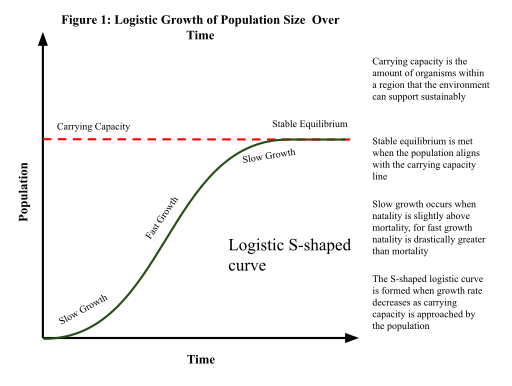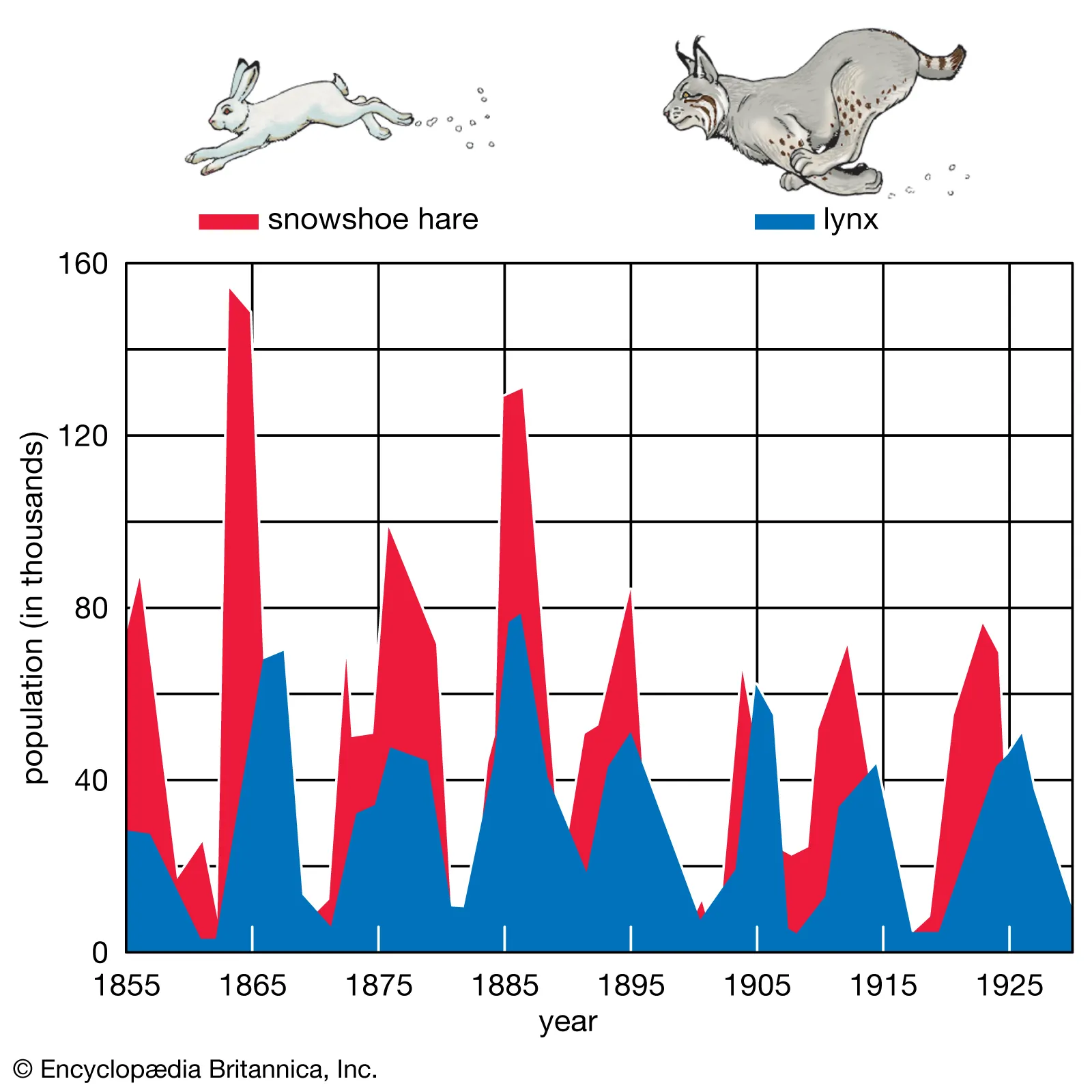OCR Specification focus:
‘Explain how limiting factors determine carrying capacity and influence final population size in a given environment.’
Population size in an ecosystem depends on how environmental conditions and biological interactions limit growth. These factors collectively establish the carrying capacity, the maximum sustainable population a habitat can support.
Population Size
The population size of a species refers to the number of individuals of that species living in a particular area at a specific time. Population dynamics describe how and why this number changes due to births, deaths, immigration, and emigration.
Population Growth Patterns
Populations typically follow a sigmoid (S-shaped) growth curve that includes three key phases:

Logistic population growth approaching carrying capacity (K). As resources become limiting, growth slows and the curve levels off at a stable equilibrium. This visual distinguishes the lag, exponential, and near-stationary phases governed by limiting factors. Source.
Lag phase – a period of slow growth while individuals acclimatise to their environment and reproduction begins.
Log (exponential) phase – rapid population increase under ideal conditions, with abundant resources and minimal limiting factors.
Stationary phase – population growth slows as limiting factors such as food shortages, competition, or disease increase, reaching a point where births and deaths balance.
EQUATION
—-----------------------------------------------------------------
Population change rate = (Births + Immigration) − (Deaths + Emigration)
—-----------------------------------------------------------------
This balance reflects how the environment imposes constraints on continuous growth.
Limiting Factors
A limiting factor is any environmental variable that restricts population growth. These can be biotic (living) or abiotic (non-living).
Abiotic Limiting Factors
Abiotic factors influence population size through physical and chemical environmental conditions:
Temperature – affects metabolic rate; extreme temperatures reduce reproduction and survival.
Light intensity – impacts photosynthesis in plants and, indirectly, food availability for herbivores.
Water availability – essential for survival; scarcity limits both plant productivity and animal distribution.
Oxygen concentration – particularly significant for aquatic species, influencing respiration and energy balance.
Nutrient availability – affects plant growth and thus entire food chains.
Populations remain small when abiotic conditions are unfavourable and expand when these conditions become optimal.
Biotic Limiting Factors
Biotic factors arise from interactions among organisms:
Competition (intraspecific and interspecific)
Predation
Disease and parasitism
Each factor regulates population numbers by influencing reproduction, mortality, or resource access.
Carrying Capacity
Carrying Capacity: The maximum population size of a species that an ecosystem can support indefinitely without degrading environmental quality.
Once a population reaches its carrying capacity, the rate of resource consumption equals the rate of resource replenishment, stabilising the population.
Regulation at Carrying Capacity
If population size exceeds carrying capacity:
Resources (e.g. food, space) become depleted.
Mortality increases and reproduction decreases.
The population declines until equilibrium is restored.
If population size falls below carrying capacity:
Resources are more abundant per individual.
Reproduction increases, leading to growth.
This dynamic equilibrium maintains balance within ecosystems.
Factors Determining Carrying Capacity
Density-Dependent Factors
Density-dependent factors intensify as population density increases:
Competition – more individuals compete for limited resources.
Predation – higher prey density may attract more predators.
Parasitism and disease – spread more easily among dense populations.
These feedback mechanisms stabilise population size near carrying capacity.
Density-Independent Factors
These affect populations regardless of density:
Natural disasters (e.g. wildfires, floods)
Extreme weather conditions
Human interference (e.g. pollution, habitat destruction)
Such factors can cause sudden, dramatic population reductions unrelated to population density.
Competition and Carrying Capacity
Intraspecific Competition
Intraspecific Competition: Competition between individuals of the same species for identical resources.
This form of competition has the strongest effect on carrying capacity, as individuals have identical requirements.
Effects include:
Reduced growth rates
Fewer reproductive opportunities
Increased mortality under resource scarcity
As resources diminish, population growth slows and stabilises at the carrying capacity.
Interspecific Competition
Interspecific Competition: Competition between individuals of different species for shared resources.
This can reduce the carrying capacity of one or both species. In some cases, one species may be entirely excluded from a habitat — known as the competitive exclusion principle, which states that no two species can occupy the same ecological niche indefinitely.
Predator–Prey Dynamics
Predation is a major biotic regulator of population size. Predator and prey populations are closely linked in cyclic patterns:

Cyclical fluctuations in prey and predator populations (hare and lynx). Peaks in hare numbers are followed by delayed peaks in lynx, then both decline as predation and resource limits intensify. This real-world dataset illustrates density-dependent regulation and time-lag effects. (Includes extra context beyond OCR by naming specific species, which is helpful but not required.) Source.
When prey populations rise, predator numbers increase due to food abundance.
As predators consume more prey, prey populations decline.
With fewer prey, predator numbers subsequently decrease, allowing prey to recover.
These oscillations demonstrate how negative feedback mechanisms stabilise ecosystems and maintain populations near carrying capacity.
Human Influence on Population Size
Humans can alter carrying capacity artificially through environmental modification:
Agriculture increases carrying capacity by enhancing food supply through irrigation, fertilisation, and pest control.
Urbanisation and pollution can reduce carrying capacity by degrading habitats and limiting available resources.
Conservation management sometimes intentionally manipulates limiting factors (e.g. predator control, habitat restoration) to support endangered species.
Such interventions demonstrate the dynamic relationship between population ecology and sustainable ecosystem management.
Population Regulation and Equilibrium
Populations rarely remain static. Fluctuations around carrying capacity occur naturally due to environmental variability, disease outbreaks, or seasonal changes. When conditions improve, populations may temporarily overshoot carrying capacity, followed by a decline as limiting factors reassert control.
The balance between growth-promoting and growth-limiting influences determines the final population size within a given environment — a central concept in ecosystem stability and sustainability.
FAQ
When a population overshoots its carrying capacity, resources such as food or space become depleted. This often leads to increased competition, starvation, and higher mortality rates.
Eventually, the population declines back below the carrying capacity — a process known as dieback or population crash.
If the environment recovers, the population may stabilise near carrying capacity again.
Repeated overshoots can permanently reduce the carrying capacity if resources or habitats are damaged.
Carrying capacity is not fixed — it fluctuates with environmental conditions. In temperate regions, for example:
Spring and summer: Higher food availability and favourable temperatures increase carrying capacity, allowing population growth.
Autumn and winter: Scarcity of food and harsher weather reduce it, causing populations to fall.
This cyclical pattern ensures populations adapt to seasonal variation through migration, hibernation, or reproductive timing.
Small populations are more affected by environmental stochasticity — random changes such as droughts, disease, or temperature shifts.
They also experience genetic drift, where random variations in reproduction or survival have a larger impact.
In contrast, larger populations buffer these effects because individual differences average out.
This instability can lead small populations toward extinction or rapid expansion if conditions improve.
Humans modify carrying capacity in both directions:
Increase: Through agriculture, irrigation, and technological innovation, humans can raise food availability and resource efficiency.
Decrease: Pollution, deforestation, and habitat loss degrade ecosystems, lowering their capacity to sustain life.
Long-term sustainability depends on maintaining resource renewal at the same rate as consumption.
Density-dependent regulation strengthens as population density rises. Examples include competition for food, disease spread, and predation. These act as feedback mechanisms to stabilise populations.
Density-independent regulation operates regardless of population density — for instance, extreme temperatures, natural disasters, or human-induced events.
Together, these factors ensure populations fluctuate around their carrying capacity rather than growing indefinitely.
Practice Questions
Question 1 (2 marks)
Explain what is meant by the term carrying capacity in the context of population ecology.
Mark scheme:
1 mark for stating that carrying capacity is the maximum population size that an environment can sustain indefinitely.
1 mark for reference to resource availability or environmental limitations (e.g. food, space, or water) that prevent further population growth.
Question 2 (5 marks)
Describe and explain the effects of limiting factors on population growth over time, referring to the shape of a sigmoid (S-shaped) growth curve.
Mark scheme:
1 mark for correctly identifying the lag phase as a period of slow population growth while organisms adapt to their environment.
1 mark for describing the log (exponential) phase where population increases rapidly due to abundant resources and minimal limiting factors.
1 mark for identifying the stationary phase where population growth slows as limiting factors increase, and births balance deaths.
1 mark for explaining that limiting factors such as competition, predation, or lack of food reduce growth rate and stabilise population size.
1 mark for linking this regulation to the carrying capacity, where the environment can no longer support additional individuals without resource depletion.

